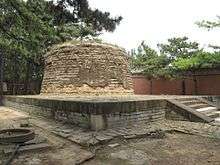Fragrant Concubine
| Khoja Iparhan/Fatimah binti Ali Khojam 和卓.伊帕爾罕 | |
|---|---|
|
Portrait of the Fragrant Concubine by Giuseppe Castiglione | |
| Born | 1734 |
| Died | 1788 (aged 53–54) |
| Spouse | Qianlong Emperor |
The Fragrant Concubine (Chinese: 香妃; pinyin: Xiāng Fēi; Uyghur: ئىپارخان / Iparxan / Ипархан) is a figure in Chinese legend who was taken as a consort by the Qianlong Emperor of the Qing dynasty in the 18th century. Although the stories about her are believed to be mythical, they may have been based on an actual concubine from western China who entered the imperial harem in 1760 and received the title "Imperial Consort Rong" (容妃; Róng Fēi). Some people insist, however, that Imperial Consort Rong (whose original name may have been Maimur Azum) and Imperial Consort Xiang were different women. Han Chinese and Uyghur tellings of the legend of the Fragrant Concubine diverge greatly, and her experience represents a powerful symbol for both figures. The story became greatly popular during the early 20th century and has since been adapted into several plays, films, and books.
Chinese legend
Although accounts vary as to some details, the basic story among Han Chinese recounts the discovery by the Qianlong Emperor of a Uyghur woman named Iparhan ("Musky Woman"), the granddaughter of Afaq Khoja, a local leader in the oasis city of Kashgar. Even more remarkable than her beauty was the scent her body naturally produced; captivated, the emperor sought her as an Imperial Consort for his harem. She was given as a gift to the emperor and carefully escorted all the way to the imperial palace in Beijing, washing every day along the road in camel's milk to preserve her mysterious fragrance.
Upon her arrival at the imperial palace, the Fragrant Concubine was given a garden and a luxurious room as a sign of the Qianlong Emperor's devotion. Homesick and distraught, she remained disconsolate as the emperor made ever-increasing efforts to recreate her distant village, building her a mosque, miniature oasis, and bazaar outside her windows in an effort to bring her happiness. Finally she relented and came to love him when he sent messengers to Kashgar to return with an jujube tree bearing golden fruit, and the Fragrant Concubine became the emperor's cherished consort until her death. An enduring symbol of national unity and reconciliation, her body was brought back to her home of Kashgar, where she is now entombed, in a procession of 120 bearers in a journey that took over three years.
Uyghur legend

Contemporary Uyghur renditions of the legend are considerably less romantic. She was the child of the ruler of the Yarkent Khanate and her name was Nur Ela Nurhan.[1] Taken away to the imperial palace in Beijing by the Qianlong Emperor, Iparhan arms herself with daggers up her sleeves, on guard against the hated advances of the emperor, until finally she was poisoned.[2]
Apak Khoja and Fragrant Concubine Tomb

The Afaq Khoja Mausoleum (mazar) located outside Kashgar was built in 1640 and, in addition to encompassing a larger complex that includes a functioning mosque and madrasa, houses the coffins of five generations of the Afak Khoja family, including what is purported to be the body of the Fragrant Concubine. In fact, the real Imperial Consort Rong died of illness in 1788 and was buried in an imperial tomb in Beijing; the legend of the Fragrant Concubine first became closely associated with the Kashgar tomb in the late 19th century, and the connection has since been officially established and endorsed through a proliferation of signs and guided tours.
In fiction
- The character Princess Fragrance in Louis Cha's wuxia novel The Book and the Sword is loosely based on the Fragrant Concubine narrative.
- The concubine also appeared as the character Han Xiang in the television series My Fair Princess, based on the novel with the same title authored by Chiung Yao.
- The 2015 television series Princess Fragrant is based on the legend.[3]
See also
References
- ↑ Wei, Cuiyi; Luckert, Karl W. (May 1998). Uighur stories from along the Silk Road. University Press of America. ISBN 978-0-7618-1137-4.
- ↑ Holdstock, Nick (30 May 2015). China's Forgotten People: Xinjiang, Terror and the Chinese State. I. B. Tauris. p. 169. ISBN 978-1-78453-140-9.
- ↑ Liang, Chen (24 August 2014). "Xinjiang fights an ideology war through cartoon production". Global Times. Retrieved 27 August 2014.
- Fuller, Graham E.; Lipman, Jonathan N. (2004). "Islam in Xinjiang". In S. Frederick Starr. Xinjiang: China's Muslim Borderland. Armonk, New York: M.E. Sharpe Inc. ISBN 0-7656-1318-2.
- Millward, James A. (1994). "A Uyghur Muslim in Qianlong's Court: The Meaning of the Fragrant Concubine". The Journal of Asian Studies. 53 (2): 427–58. doi:10.2307/2059841.
- Tyler, Christian (2003). Wild West China: The Taming of Xinjiang. London: John Murray. ISBN 0-8135-3533-6.